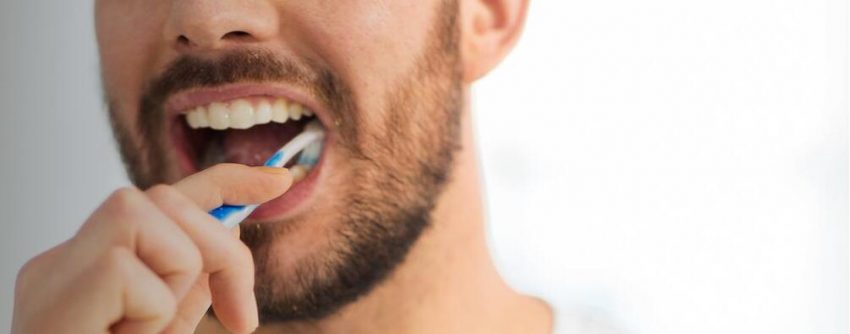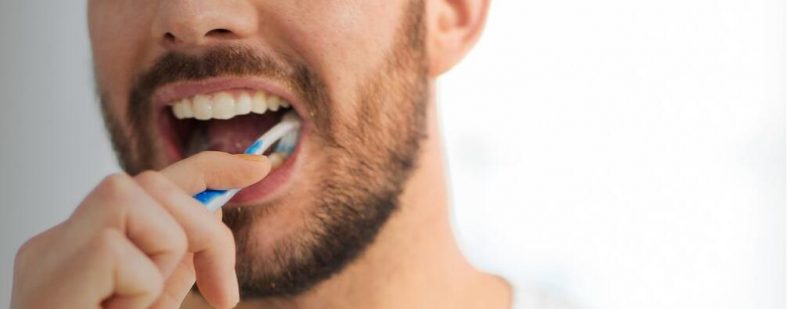In contrast to tooth decay and periodontal disease, abrasion or tooth wear is a less well-known issue as a threat to dental health. What are the causes and how can you protect yourself against the loss of tooth structure?
- Abrasion or abrasion dentium refers to the wear and tear of hard tooth substance.
- Attrition is the wear and tear caused by strong friction between teeth, for example when teeth grinding at night.
- In the case of erosion, the loss of substance on the teeth occurs through the action of acid.
- Demastication, the grinding of teeth by very hard particles in food, is rare in western industrialized nations.
What is abrasion?
Abrasion or Abrasio dentium (Latin abrasio = wear) describes in dentistry the wear and tear of the hard tooth substance. If the outermost, relatively hard tooth layer, the tooth enamel, is worn out, the underlying dentin or dentin comes to the surface. However, dentin is softer than tooth enamel and abrasion of the tooth is even faster.
Tooth wear can have various causes and forms. Thus, attrition, erosion and Demastikation lower forms of curettage dentium with their own symptoms and causes.
Forms of abrasion
Attrition
In attrition, the teeth are abraded by the strong rubbing of the teeth against one another. Usually the chewing surfaces of the posterior teeth are most affected, but often individual teeth or the anterior teeth are also severely removed. The grinding and clenching of teeth that cause attrition is called bruxism in dentistry.
Bruxism
Bruxism often occurs at night, but sometimes also during the day when there is great tension or stress . In bruxism, the teeth are pressed tightly against one another or rubbed against one another with high pressure, so that the tooth substance is rubbed off, various muscle groups on the head and jaw are impaired and the teeth holding apparatus are extremely stressed.
erosion
Dentistry defines erosion as the loss of hard tooth substance due to the effects of various types of acid. The erosive acids can get into the mouth with food, and they can come from the body.
- Exogenous erosion: Acids that attack tooth enamel often come from beverages such as juices, ice and fruit teas, lemonades or energy drinks or foods such as fruit, vinegar, spinach and rhubarb (oxalic acid), sour milk products or sauerkraut (lactic acid). Even sugar, for example from candy, is converted into acids by the bacteria in the saliva and thus attacks the tooth enamel.
- Endogenous erosion: As the body’s own acid, hydrochloric acid in gastric juice can get into the mouth through vomiting. Eroded teeth are a common symptom of the bulimic eating disorder , where people induce vomiting in order not to gain weight. Even with acid regurgitation as a result of reflux disease, stomach acid gets into the mouth and can attack and destroy the tooth enamel.
Demastication
Demastication is a form of abrasion in which the loss of tooth substance is caused by food. This happens either because the food itself is harder than the enamel or because there are tough impurities in the food. In both cases, the chewing surfaces, especially the posterior teeth, are abraded by the hard particles in the food pulp. In earlier centuries, millstones that were more heavily worn due to an imbalance, for example, and mixed stone powder with the grist, could lead to the rapid wear of the teeth of the residents of the surrounding settlements, as studies of historical skulls show.
Today, tooth damage caused by demastication can still be found in indigenous peoples; in the western industrialized countries with their heavily processed and cleaned foods, this form of erosion hardly occurs.
Incorrect dental care
Also through to hard toothbrushes , highly abrasive toothpastes, flat cleaning techniques and much pressure when brushing can arise abrasion. The timing of your teeth brushing can also have an adverse effect on tooth wear: When you brush your teeth immediately after eating, acids in the food or sugars converted into acid by bacteria can contribute to the tooth enamel being more eroded during the brushing process.
Other reasons for abrasion
In addition to mechanical causes , such as frequent biting into objects, such as a tobacco pipe, insufficient saliva production can be another cause of abrasion. Certain illnesses, but also the use of certain medications and the consumption of drugs, can ensure that overstimulation of the sympathetic system reduces the formation of saliva.
Since the saliva is responsible for the remineralization of our teeth, damage to tooth enamel and dentin occurs so quickly. This effect is very pronounced with amphetamines such as crystal meth. Rotten teeth due to rapidly degrading tooth substance are therefore also called “meth mouth”.
RDA value of the toothpaste
RDA stands for Relative Dentin Abrasion and indicates how much the cleaning particles in the toothpaste remove the tooth substance. Toothpastes with low RDA values are less effective in cleaning, but are also less abrasive and therefore more gentle on the tooth substance. For consumers, the indication of the RDA value on the toothpaste packaging would be extremely useful for choosing the right toothpaste.
RDA values in comparison:
- RDA> 80: very highly abrasive
- RDA = 60 – 80: highly abrasive
- RDA = 40 – 60: medium abrasive
- RDA = 20 – 40: not very abrasive
- RDA = 0 – 20: very little abrasive
Consequences of abrasion
When the teeth are abraded, the masticatory muscles and often the rest of the body try to compensate for the change that has resulted from the loss of tooth substance. Because when the tooth substance is severely worn, the bite height is increasingly incorrect because the teeth have become shorter. This not only disrupts the aesthetics and overall appearance of the teeth, but also causes functional disorders such as TMJ syndrome or malfunctioning teeth and can lead to the loss of teeth.
Prevent abrasion
Depending on the cause, you can prevent abrasion of the teeth by attrition with a bite splint to prevent teeth grinding at night or possibly by reducing stress. For example, if you experience acid erosion, you should review your eating habits and avoid foods that are high in acid or sugar. A softer toothbrush, toothpastes with enamel-hardening fluorine and a low RDA value as well as the right time to brush can help prevent the tooth substance from being broken down any further.

